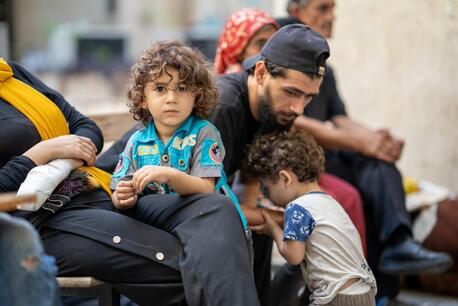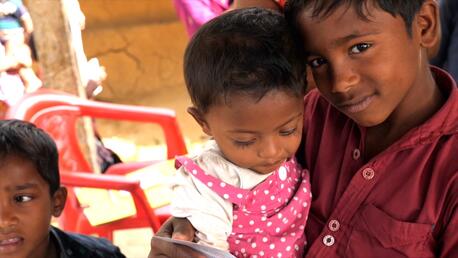
Afghanistan Refugees: Help Save Refugee Children
There are millions of Afghanistan refugees. UNICEF is on the ground providing urgent assistance to vulnerable children and families who have fled across borders or are internally displaced.
The humanitarian crisis in Afghanistan has reached unprecedented levels.
Political and socio-economic developments over the past year brought even more turmoil to a country that has experienced 40 years of prolonged conflict, chronic poverty, recurrent natural disasters and widespread food insecurity. Every other child under five years is acutely malnourished.
More than half of the population of Afghanistan — over 24 million people — need urgent humanitarian assistance, including 13 million children.
Millions of Afghanistan refugees have fled the country hoping for a better future, and millions more are internally displaced.
UNICEF is committed to securing a better future for the children in the country and providing support to the Afghanistan refugee crisis.

Mahbubeh, 9, center, stands with her brother, Zaid Allah, 6, and her sister Nazi, 4, near the rubble of their old family home in Barmal District, Paktika Province, Afghanistan. The rest of their family perished in the recent earthquake and so the siblings now live with an aunt. © UNICEF/UN0665331/Bidel
About the Crisis in Afghanistan
UNICEF has been on the ground in Afghanistan for decades, and is one of the longest-serving international organizations in the country.
In response to current and pressing needs, UNICEF is scaling up lifesaving programs for children and women and delivering more food, medicine and other support to displaced families.
UNICEF's priorities for humanitarian action in Afghanistan are to:
- admit children suffering from severe acute malnutrition (SAM) for treatment
- vaccinate children against measles
- provide families with enough safe drinking water
- make sure millions of children who are not in school can still receive an education
UNICEF has long worked with partners in Afghanistan to build trust with communities and to negotiate for humanitarian access to children and families in need with all parties to conflict, becoming skilled at delivering lifesaving supplies in difficult circumstances.
Afghanistan: How many refugees are there and where will they go?
Six million Afghans have been forced to leave their homes due to conflict, violence or poverty. The majority of the Afghans fleeing are internally displaced.
An increasing number of people are fleeing Afghanistan due to the deteriorating humanitarian situation, including political instability, natural disasters, lack of water and food or lack of economic opportunity.
There are at least 2.5 million Afghanistan refugees. The majority are seeking protection and asylum in neighboring countries, including Iran, Pakistan, Tajikistan, Turkmenistan and Uzbekistan.
Families are often forced to make desperate decisions, such as encouraging their children to find work outside the country. These children on the move often leave Afghanistan, sometimes for several years, hoping to make money and provide for their families. Most get involved in unofficial low-wage jobs or work for small businesses. If the children return to Afghanistan, they often carry trauma and face the challenges of having been out of school for years.
Stories of Afghanistan Refugees
Here are a few stories about the people UNICEF has reached through its programming.
Supporting refugee adolescents with skills-building courses
Waranga is a 16-year-old Afghan refugee girl who has been living in Tajikistan with her family for the past several years after fleeing Afghanistan. She had not been able to continue studying due to her family’s economic situation, so when she learned about UNICEF-supported skills-building courses for adolescents in 2021, she enrolled right away.
“Together with another three girls, we were able to lead on an invention to support the local ecology," Waranga says. "Who would ever think that an Afghan girl would ever engage in an engineering project?”
16-year-old Waranga Sarfaroz with her four teammates from the UNICEF UPSHIFT program were concerned with the lack of specialized tools for cleaning the streets by the local municipality. To tackle this problem, they designed the PICKUP tool, which helps to grab the garbage on the streets on Vahdat and contribute to a cleaner environment in the community. © UNICEF/UN0571425/Ruziev
Treating children suffering from severe acute malnutrition
Basmina, a 4-year-old girl, received treatment for severe acute malnutrition in a UNICEF-supported hospital. Basmina lost her mother, and her father lost his job. Her 13-year-old sister brought her to the hospital for care. After a few weeks, the treatment Basmina received restored her health enough that she could return home.

Basmina, a 4-year-old girl, sits in a bed where she is being cared for at the UNICEF-supported SAM IPD at Paktya Regional Hospital. © UNICEF/UN0631339/Al-Janabi
A safe space For children in the devastating aftermath of the 2022 earthquake
Eight-year-old Abubakr plays in a UNICEF-supported Child-Friendly Space in Gayan District, Paktika Province, Afghanistan. The children who come here have lost homes and family members in the recent earthquake that devastated the Khost and Paktika Provinces. The earthquake killed over 1,000 people and injured over 3,600. Many of these children lost family members, and their lives have been turned upside down. The Child-Friendly Space offers social workers and counselors to help these children.

Abubakr, 8, plays in a UNICEF-supported child-friendly space in Gayan District, Paktika Province, Afghanistan. ©UNICEF/UN0665312/Bidel
The current situation in Afghanistan
- an estimated 3.7 million children are not in school – 60 percent of them are girls
- child marriages are illegal but widespread; one-third of Afghan girls marry before their 18th birthday
- 58 children for every 1,000 live births die before their 5th birthday
- 41 percent of children under age 5 experience stunting; 9.5 percent suffer from severe wasting, the extreme manifestation of severe acute malnutrition
How UNICEF supports children in Afghanistan
UNICEF provides support across all program areas, including health, education and child protection. Here are some highlights from the first half of 2022:
- 247,000 children treated for severe acute malnutrition with 6.5 million children receiving screening
- over 1.2 million people reached with safe water
- 283,000 children provided with education opportunities
- cash transfers given to nearly 100,000 households, distributing more than $20 million in aid directly to families
History of UNICEF’s dedication to children in Afghanistan
UNICEF has been on the ground in Afghanistan for over 70 years with offices nationwide and a range of partners that support the organization. Some highlights of UNICEF’s recent work include:
Giving children a healthy childhood
- testing children for severe acute malnutrition (SAM) and admitting those in need to treatment centers
- providing children under one year with life-saving vaccines against nine dangerous diseases
- treating pregnant women and children who live over two hours away from a health facility through mobile health teams
- providing safe water to families who do not have access
Protecting children's rights
- setting up Child-Friendly Spaces to provide a place where children can play, learn, and socialize during and after humanitarian emergencies
- helping unaccompanied minors reintegrate into their home when returning from neighboring countries and supporting reunification with their families
- increasing mental health and psychosocial support for children in need
- engaging communities to protect children from practices like child marriage, violent corporal punishment, domestic abuse, and child labor
Paving a brighter future with the opportunity to learn
- providing vocational training or apprenticeship programs for children at risk of fleeing the country
- continuing to build out community-based learning opportunities for underserved students in remote communities
- ensuring female teachers are present in classrooms, creating and sustaining learning spaces that are closer to students’ homes, and other measures that improve girls' chances of staying in school
- providing emergency education to children during disasters and conflicts

Abdul Ghafor, 8, left, and Zolgi, 7, play with blocks and balls in a UNICEF-supported child-friendly space in Gayan District, Paktika Province, Afghanistan. © UNICEF/UN0665309/Bidel
How to help Afghanistan’s children
The needs of vulnerable Afghan children and their families are unprecedented. Support UNICEF's efforts to deliver essential nutrition and health services, protection and education to vulnerable children in Afghanistan. Donate today.
Further reading
Making a Difference in Afghanistan
This Ramadan Many families in Afghanistan do not have enough food. UNICEF brought much-needed relief to children.
A Mother From Afghanistan Reflects on Her Family’s Life
This Ramadan Millions of children and families could not have a proper meal to start and break their fast during Ramadan due to ongoing widespread food insecurity.
UNICEF Reaching Those in Need After Afghanistan’s Deadly Earthquake
Thousands of families in southeastern Afghanistan's lives were at risk after a devastating earthquake shook Paktika and Khost provinces on June 22, 2022, killing more than 1,000 people and injuring over 1,600, including at least 120 children
Top photo: Ahmad, 4, inside a multipurpose tent where he enjoys reading and writing. In 2021, UNICEF implemented a winterized High-Performance Tent, an innovation that provides a safe, warm, and comfortable space for children in the face of freezing temperatures in the mountainous regions of Afghanistan. © UNICEF/UN0443250/Fazel
HOW TO HELP
There are many ways to make a difference
War, famine, poverty, natural disasters — threats to the world's children keep coming. But UNICEF won't stop working to keep children healthy and safe.
UNICEF works in over 190 countries and territories — more places than any other children's organization. UNICEF has the world's largest humanitarian warehouse and, when disaster strikes, can get supplies almost anywhere within 72 hours. Constantly innovating, always advocating for a better world for children, UNICEF works to ensure that every child can grow up healthy, educated, protected and respected.
Would you like to help give all children the opportunity to reach their full potential? There are many ways to get involved.




